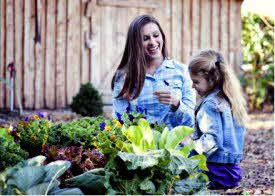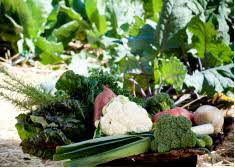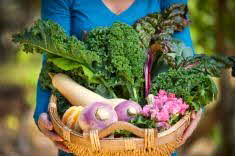COOL WEATHER CROPS ARE HOT THIS FALL
|
|
There’s still time for a second season of gardening. Many of us think of vegetable gardens as something to be started in spring for a summer harvest—truly savvy gardeners know that mid to end of summer is a great time to plant cool weather crops for fall harvest. Below are some info and tips for fall gardening.
The growing season isn’t over with the arrival of cool weather. Until the first hard frost hits, you have plenty of time to plant, pick and plate cool-weather crops – You’ll save yourself some money in the grocery’s produce aisle too.

Fall is a great time for gardening thanks to cooler, milder temperatures, a decrease in garden pests, and moister, well-draining soil. These conditions make it ideal for crops that prefer cooler weather. Some vegetables taste even better when nipped by light frost.
July through August is the optimum time for planting cool crops, so don’t delay. Planting in summer ensures crops will have time to mature before the first freeze in fall. Choose varieties that mature quickly; you can find the days to maturity on plant tags. Starting with transplants, rather than seed, will help make the growing process much easier.
If you’ve been diligent in your garden all summer, you won’t have much work to do preparing it for cool crops. If your garden got a little ahead of your efforts, don’t worry. It won’t take long to get it into tip-top shape for a second season of planting.
Just follow these simple steps:
Tidy up:
Remove spent plants, like early planted beans, cucumbers or lettuce, since they’re pretty much done for the season and can harbor pests. Clear away holes left from pulling plants, and get rid of weeds before they go to seed. Throw away anything distressed and compost the rest.
Discard any fallen fruits, rotting produce can attract pests. Take note of where everything was planted so you can be sure to rotate crops.

Set up the soil:
Freshen garden soil by removing the existing layer of mulch and replace it. Straw makes an excellent cover because it’s easily scattered, it’s also a favorite home for spiders that will help control insect pests in your garden. You can also use a layer of shredded leaves for mulch.
Loosen compacted soil and fluff it up with a garden fork. Major tilling isn’t necessary; just move soil enough to allow new plant roots to settle in and let water get through. Test soil (you can buy a testing kit at most garden retailers) to see if it needs help. Add amendments, if needed. At the very least, work some compost in where your plants will be growing.
If you’ll be using a cold frame or hoop, set it up early so that it’ll be ready to go when you need it and you won’t risk damaging plants and roots once they begin to grow.

Pick your plants:
Starting with transplants will buy you lots of time. Since plants are six weeks or older when you put them in the ground, you’ll harvest sooner than if you start from seed. Look for transplants from an established grower, like Bonnie Plants. Sold in biodegradable, environmentally friendly pots, you’ll find fall varieties selected for your geographic region at most local garden retailers.
Here are some top crops for fall planting:
* Top Bunch Collards – This hybrid is heavy yielding, early maturing, and more uniform than traditional varieties. They grow best in full sun, tolerate partial shade, are rich in vitamins and sweetened by frost. Space transplants 36 inches apart.
* Spinach – A cool-weather vegetable related to beets and Swiss chard, Bonnie’s Spinach is a fast-growing plant, yielding many leaves in a short time in fall. Although spinach prefers full sun, it’s one of the few vegetables that produce a respectable harvest in partial shade.
* Winterbor Kale – This nutritious leafy green is a vigorous producer that endures winter easily. Cut the outer leaves so that the center can continue growing. Space transplants 12 inches apart.
* Early Dividend Broccoli - Popular, productive and easy to grow, this broccoli is high in fiber and calcium. Space transplants 18 inches apart.
* Mustard greens – Offering spicy hot leaves, this is a very fast-growing, nutritious vegetable, and always tastes sweeter when nipped by frost. Space plants 12 inches apart.
* Bonnie Hybrid Cabbage – Grows large, round, blue-green heads. Cabbage is especially high in beta-carotene, vitamin C, K and fiber.
Get started now to ensure your fall harvest is healthy, hefty and fulfilling. With preparation, the right plants and some diligence, you can bet on fresh, low-cost produce well into fall. For more information on vegetable and herb varieties, gardening tips, ideas and advice, visit www.bonnieplants.com
RELATED ARTICLES:
Please feel free to link to any pages of FoodReference.com from your website.
For permission to use any of this content please E-mail: james@foodreference.com
All contents are copyright © 1990 - 2014 James T. Ehler and www.FoodReference.com unless otherwise noted.
All rights reserved.
You may copy and use portions of this website for non-commercial, personal use only.
Any other use of these materials without prior written authorization is not very nice and violates the copyright.
Please take the time to request permission.
CULINARY SCHOOLS &
COOKING CLASSES
From Amateur & Basic Cooking Classes to Professional Chef Training & Degrees
More than 1,000 schools & classes listed for all 50 States, Online and Worldwide
FREE Food & Beverage Publications
An extensive selection of free magazines and other publications for qualified Food, Beverage & Hospitality professionals


